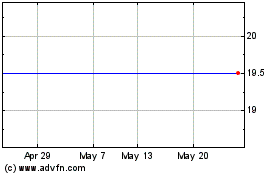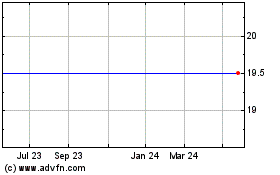TIDMPELE
RNS Number : 5962F
Petrolatina Energy PLC
28 April 2011
28 April 2011
PetroLatina Energy Plc
("PetroLatina" or the "Company")
Resource Update
Proved, Probable and Possible Reserves Independently Valued at
$280 million
PetroLatina (AIM: PELE), the independent oil and gas
exploration, development and production company focused on Latin
America, announces that Ryder Scott Company, L.P. ("Ryder Scott"),
the independent petroleum consultants, has recently completed an
updated assessment of the reserves, future production and income
attributable to the Company's concessions in Colombia as at 31
December 2010.
Ryder Scott reported that as at 31 December 2010:
- Proven Net Reserves of the Company stood at 3.518 million
barrels of oil ("bbls") (30 November 2009: approximately 3.359
million bbls), representing replacement of approximately 105% of
the Proven Reserves produced in the period between the two
reports.
- Proved gas reserves contained in the Serafin field stood at
1.33 billion cubic feet ("Bcf") (30 November 2009: approximately
1.15 Bcf). As announced recently, the Serafin-1 gas well was placed
on extended test production in late March 2011.
- Probable Net Reserves of the Company stood at 2.147 million
bbls (30 November 2009: approximately 2.537 million bbls). This
decrease occurred almost entirely in the Santa Lucia field and
resulted from a combination of Ryder Scott assuming a lower
ultimate recovery factor than in the past for the producing La Paz
formation and revised lower production rate expectations for the
same formation as a result of additional production rate history
acquired since the previous report. In its current report Ryder
Scott has designated two additional locations in the Santa Lucia
field as Proven, however, these are not reflected in the Proven or
Probable Reserves figures as PetroLatina has not submitted a
drilling programme and development plan for these two locations to
date. As the Company holds a relatively small (14% net after
royalty) interest in this field compared to its interest in other
fields (such as Colon where it holds a 78.2% net interest after
royalty) management currently intends focusing the Company's
resources and capital expenditure on such other higher impact
fields in the near term.
- In accordance with the above, the 2P (Proven plus Probable)
Reserves of the Company as at 31 December 2010 were 5.88 million
barrels of oil equivalent ("boe") (30 November 2009: approximately
6.09 million boe) comprising 5.665 million bbls of oil and 1.33 Bcf
of gas (30 November 2009: approximately 5.896 million bbls and 1.15
Bcf).
- Possible Net Reserves of the Company stood at 4.005 million
bbls (30 November 2009: approximately 5.316 million bbls). The
decrease in this category results primarily from the removal, by
Ryder Scott, of previously designated Possible Reserves in the
deeper Umir formation in the Santa Lucia field. Although the Umir
formation there is known to be oil bearing on the basis of drill
stem tests conducted when the wells were initially drilled, the
fact that the Company has not yet submitted a development plan for
the development of these deeper reserves has prompted this
revision. As mentioned above with regards to the Santa Lucia
Probable Reserves, the Company holds much higher interests in its
other producing fields and accordingly intends to concentrate its
efforts and financial resources on these higher impact fields in
the near term.
- In accordance with the above, the 3P (Proven plus Probable
plus Possible) Reserves of the Company as at 31 December 2010 were
9.9105 million barrels of oil equivalent ("boe") (30 November 2009:
approximately 11.406 million boe) comprising 9.671 million bbls of
oil and 1.33 Bcf of gas (30 November 2009: approximately 11.212
million bbls and 1.15 Bcf).
The Ryder Scott report has provided a clear basis for the
formulation of future drilling plans and consequent production rate
and reserves increases. It defined a significant number of 'Proven
Undeveloped' future drilling locations, including four at the Colon
field and seven at the Querubin field. At Querubin, recent drilling
results and the use of a more effective production method (a
progressive cavity pump) has proved that a gross production rate of
approximately 150bbls per day can be maintained in an area where
wells with thick oil pay were previously found to be unproduceable
due to sand production problems.
The Company's Proven hydrocarbon reserves comprise approximately
94% oil and 6% gas.
Prospective Resources based on a Ryder Scott review of the
Company's exploration portfolio, and which found that its
exploration methods and estimates were reasonable, are estimated as
at 31 December 2010 to be approximately 22.8 million barrels of
gross recoverable oil (8.72 million barrels net to the Company) on
an unrisked basis. These Prospective Resources principally relate
to resources potentially recoverable from:
(a) Additional development drilling in the Santa Lucia field
where considerable resources appear to exist in the Lisama
formation. Ryder Scott's petrophysics indicate that this formation
contains untested potentially oil bearing pay zones. This area is
held under Association Contract terms and the Company has a 17.5%
working interest (14% net after royalty) in this concession.
(b) The Juglar , Colon deep and shallow Prospects located on the
La Paloma Block which is held under an Agencia Nacional de
Hidrocarburos ("ANH") contract and in which the Company has an 85%
working interest (78.2% net after royalty).
(c) The Putumayo-4 Block granted under ANH terms and in which
the Company holds a 50% working interest. This block contains two
exploration leads over which new seismic acquisition is planned in
July 2011 and drilling is planned within the next 18 months, once
community consultation ends and an environmental licence is
approved.
In addition to the above, and not included in Ryder Scott's
review, PetroLatina has mapped several leads in its VMM28 block
which lies adjacent to the Company's currently producing acreage.
This block was granted under ANH terms in mid 2010 and is now under
exploration.
NPV10
Based upon the average oil price received in 2010 ($79.43 per
barrel) and as adjusted to actual prices received by the Company
for each property, the Net Present Value at a 10 per cent. discount
("NPV10") of the aforementioned Proved Reserves was estimated by
Ryder Scott at $94.5 million (30 November 2009: $71 million). The
NPV10 of the 2P reserves totalled $138.8 million (30 November 2009:
$140.3 million) and the NPV10 of the 3P reserves totalled $280.6
million (30 November 2009: $247.0 million).
The above NPV10 valuations do not take account of the
exploration potential in respect of the Company's interests in
Colombia which the Directors believe could be substantial.
Furthermore, Ryder Scott's assessment does not include any
valuation of the Company's Rio Zulia-Ayacucho pipeline asset in the
Catatumbo basin.
Juan Carlos Rodriguez, Chief Executive Officer of PetroLatina,
said:
"We believe the recently completed Ryder Scott report, combined
with the various technical studies now nearing completion by other
third party specialist consultants, provides the Company with a
clear road map for further drilling later this year. I am confident
that such additional drilling in a more effective and low risk
manner will ultimately result in significantly increased production
and reserves."
A copy of the executive summary from Ryder Scott's report will
shortly be made available on PetroLatina's website at
www.petrolatinaenergy.com. As in all aspects of oil and gas
evaluation, there are uncertainties inherent in the interpretation
of engineering data and all conclusions represent only informed
professional judgments.
Proved and probable oil and gas reserves are estimated
quantities of commercially producible hydrocarbons which the
existing geological, geophysical and engineering data show to be
recoverable in future years from known reservoirs. The Proved
Reserves reported by Ryder Scott, conform to the definition
approved by, inter alia, both the Society of Petroleum Engineers
("SPE") and the World Petroleum Council ("WPC"). The Probable
Reserves and Possible Reserves reported by Ryder Scott conform to
the definitions of Probable and Possible Reserves approved by the
SPE and WPC using the deterministic methodology.
Mr Menno Wiebe, a Non-executive director of the Company, has
reviewed and approved the technical information contained within
this announcement in his capacity as a qualified person, as
required under the AIM rules. Mr Wiebe is a Petroleum Geologist and
has been a Member of the American Association of Petroleum
Geologists for more than 30 years and a Member of the Geological
Society for more than 7 years.
Enquiries:
PetroLatina Energy Plc Tel: +57 1627 8435
Juan Carlos Rodriguez, Chief Executive Officer
Pawan Sharma, Executive Vice President - Corporate Tel: +44 (0)20 7766 0081
Affairs
Strand Hanson Limited
Simon Raggett / Matthew Chandler Tel: +44 (0)20 7409 3494
Evolution Securities Limited
Chris Sim / Adam James Tel: +44 (0)20 7071 4304
Financial Dynamics
Ben Brewerton / Susan Quigley Tel: +44 (0)20 7831 3113
Glossary of key technical terms:
2P the sum of Proved Reserves plus Probable Reserves.
3P the sum of Proved, Probable and Possible Reserves.
AAPG American Association of Petroleum Geologists
Boe gas is converted to barrels of oil equivalent
at the standard ratio of 1 barrel of oil = 6
thousand cubic feet of natural gas.
NPV10 the net present value of estimated future revenues
to be generated from the production of reserves
discounted using an annual discount rate of 10%.
Possible Reserves those unproved reserves which analysis of geological
and engineering data suggests are less likely
to be recoverable than probable reserves. In
this context, when probabilistic methods are
used, there should be at least a 10% probability
that the quantities actually recovered will equal
or exceed the sum of estimated Proved plus Probable
plus Possible reserves.
Probable Reserves those unproved reserves which analysis of geological
and engineering data suggests are more likely
than not to be recoverable. In this context,
when probabilistic methods are used, there should
be at least a 50% probability that the quantities
actually recovered will equal or exceed the sum
of estimated Proved plus Probable reserves.
Prospective Resources those quantities of petroleum which are estimated, as
of a given date, to be potentially recoverable from
undiscovered accumulations. Potential accumulations
are evaluated according to their chance of discovery
and, assuming a discovery, the estimated quantities
that would be recoverable under defined development
projects. It is recognised that the development
programmes will be of significantly less detail and
depend more heavily on analogue developments in the
earlier phases of exploration.
Proved Reserves or those quantities of petroleum which, by analysis of
1P geological and engineering data, can be estimated
with reasonable certainty to be commercially
recoverable, from a given date forward, from known
reservoirs and under current economic conditions,
operating methods and government regulations. Proved
reserves can be categorised as developed or
undeveloped. If deterministic methods are used, the
term reasonable certainty is intended to express a
high degree of confidence that the quantities will be
recovered. If probabilistic methods are used, there
should be at least a 90% probability that the
quantities actually recovered will equal or exceed
the estimate.
SPE The Society of Petroleum Engineers.
Unproved Reserves based on geologic and/or engineering data similar to
that used in estimates of proved reserves; but
technical, contractual, economic or regulatory
uncertainties preclude such reserves being classified
as proved. Unproved reserves may be further
classified as probable reserves and possible
reserves.
WPC World Petroleum Council.
This information is provided by RNS
The company news service from the London Stock Exchange
END
MSCSEEEFWFFSELL
Petrolatina Energy (LSE:PELE)
Historical Stock Chart
From Jun 2024 to Jul 2024

Petrolatina Energy (LSE:PELE)
Historical Stock Chart
From Jul 2023 to Jul 2024
